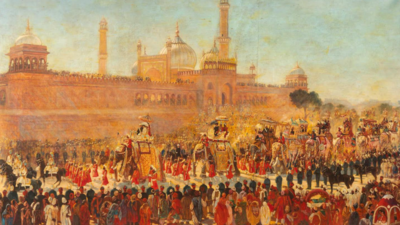ARTICLE AD BOX

Although Satish Gujral—celebrating his centenary this year—is best known as a pioneering Indian artist, few know about his impact on Delhi’s post-independence architectural landscape.One of his most celebrated creations is the Belgian Embassy in New Delhi.
Completed in 1983, the embassy was among the first prominent diplomatic buildings in the capital’s Chanakyapuri enclave to be designed not by a European or Western architect, but by an Indian artist. And Gujaral did not even have any formal architectural training.The building’s bold design language—defined by its igloo-shaped domes and fortress-like form in exposed red-brick—reinterpreted traditional Indian motifs through a modern lens and went on to win international acclaim.
It became a symbol of India’s architectural self-confidence, transforming the Embassy into not just an administrative center but a cultural landmark in its own right. It is only fitting that the Embassy served as the inaugural venue for DAG’s arts and heritage festival, 'The City as a Museum'.
Running from September 6 to 21, the festival opened with an exclusive showcase inside the Embassy featuring two artworks by Gujral from the early 1970s—acquired by DAG from a Belgian collector.

Independence Day Celebration, Delhi (late 20th century) in opaque watercolour with pigment on paperFeaturing a rich array of exhibitions, talks, performances and walks—including one inside the Belgian Embassy—'The City as Museum' aims to highlight overlooked artists and movements, restoring their legacies within the broader narrative of Indian art history. Launched in 2021 with its inaugural edition in Kolkata, followed by Mumbai earlier this year, Delhi’s premier art gallery, DAG, returns to its home city with a debut festival that is reportedly the largest in scale to date.
By activating the entire city through its historic sites, artists’ homes and studios, archives, performance spaces and cultural landmarks, DAG’s expansive programming across the capital aims to bring art out into the open beyond the conventional gallery. "If the discoveries in the planning stage are any indication, this will be one of the most refreshing, inventive and interesting ways the people of this remarkable metropolis will re-visit the city they call home,” says Ashish Anand, CEO and MD of DAG, about the festival, which quickly sold out after being announced on social media.
“We have plans to expand this festival into a pan-India event,” Anand tells TOI.The Delhi edition will offer a rich lineup of events. Starting with a morning walk through Qudsia Bagh, an 18th-century Mughal garden and palace, where historian Swapna Liddle highlights its role in the historic 1903 Delhi Durbar art exhibition—one of India’s earliest formal art showcases, festival-goers can move on to the exploration of the Daryaganj Sunday Book Market with ‘A Bibliophile’s Bazaar,’ while historian Rudrangshu Mukherjee will revisit Delhi’s transformation after the 1857 Revolt through powerful photographs.Theatre enthusiasts can catch a preview of the Shadipur Natak Utsav by Studio Safdar, which celebrates the lasting impact of children on community theatre. The festival’s musical core, ‘The Fifth Circle,’ curated by Amitesh Grover, features an immersive audio walk through Mandi House, alongside performances blending folk, rock, qawwali, and songs of resistance. Conversations with artists and their families will bring to life Delhi’s post-independence artists’ colonies like Garhi Village and Bharati Artists’ Colony.
In the centenary year of Krishen Khanna, Tyeb Mehta and Gujral, the festival spotlights Khanna’s monumental mural ‘The Great Procession’ at ITC Maurya, along with a guided walk through the hotel’s WelcomArt collection.An archival journey will revisit ‘The Illustrated Weekly of India', a publication that once shaped post-independence cultural life for English readers nationwide. The festival concludes with a vinyl listening session curated by music archivist Nishant Mittal, featuring a playlist of beloved, long-forgotten tunes that once filled Delhi’s bazaars and homes.The central exhibition of the festival, 'Sair-e-Dilli: Chronicles of Change,' opens at Bikaner House on September 7. It features an extensive collection of paintings, prints, photographs and large guide maps that together weave a nuanced, layered story of the capital—from the Sultanate and Mughal periods to Lutyens’ Delhi. "This exhibition shows how dramatically Delhi has expanded. How a sparsely populated city grew so much over time," says Liddle, curator of 'Sair-e-Dilli'.



.png)
.png)
.png)
















 2 hours ago
3
2 hours ago
3







 English (US) ·
English (US) ·